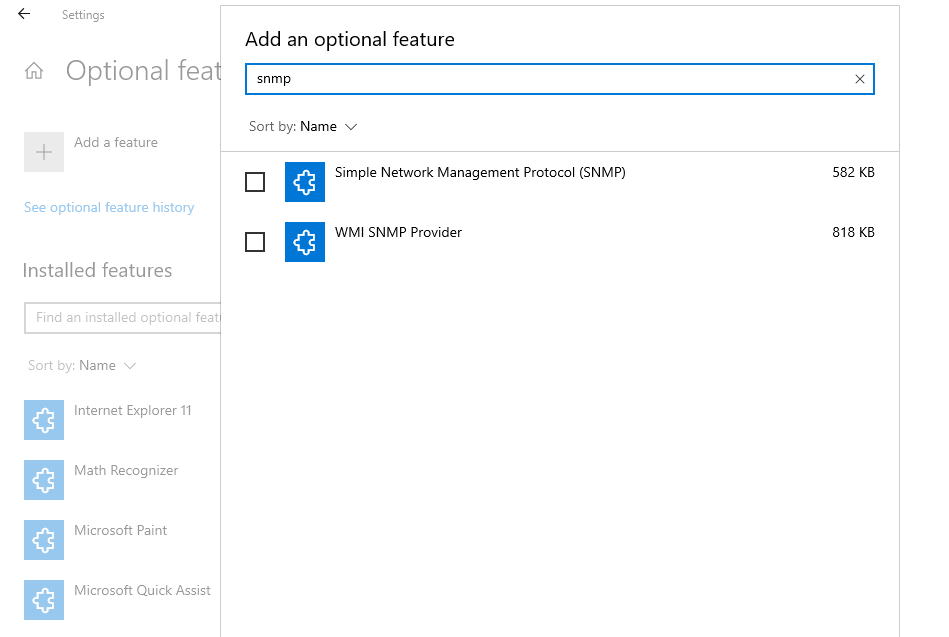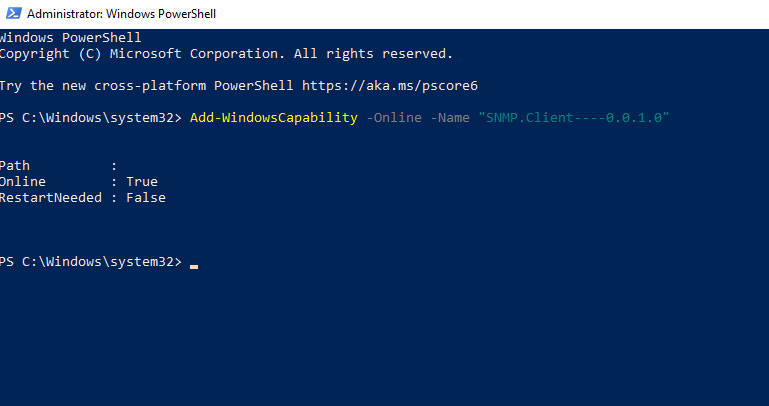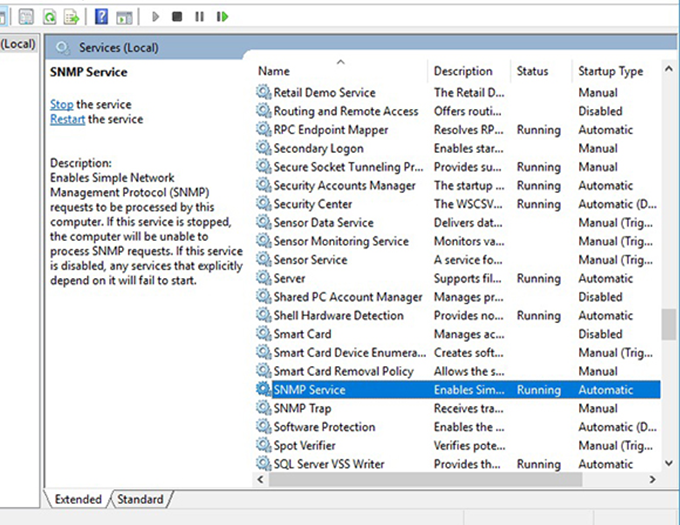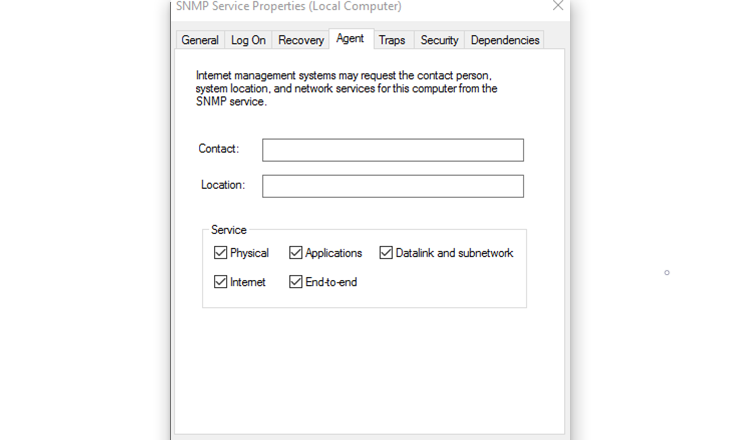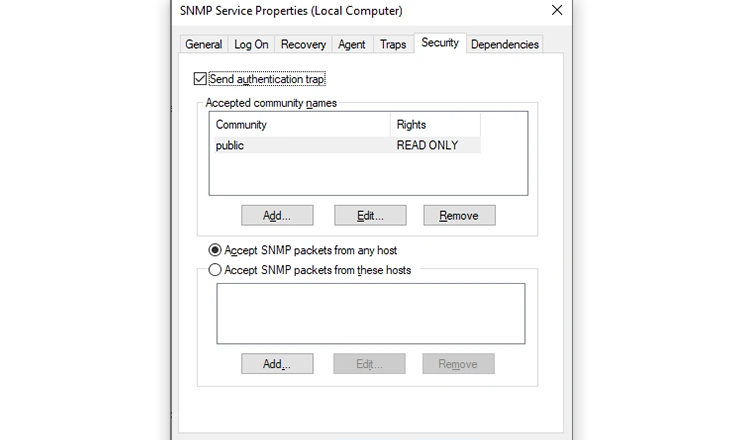Simple Network Management Protocol (SNMP) is an application layer protocol that allows network devices to share information, regardless of the differences in hardware or software. In absence of SNMP, network management tools are unable to identify devices, record network changes, monitor the performance of the network, or ascertain a network device's status in real-time.
Earlier, you could use the Turn Windows Features on and off section in Control Panel to enable or disable SNMP. Starting Windows 1803 and later, Microsoft has deprecated the feature because of the associated security risks and recommends using the Common Information Model (CIM) instead. Regardless, if you want to install and enable SNMP on your PC, we'll show you how you can.
How to Enable SNMP From the Settings
SNMP is available as an optional feature on Windows 10. You can enable optional features by navigating to Settings > Apps > Apps & features > Optional features. Click on Add a feature and search for snmp. Select Simple Network Management Protocol (SNMP) and WMI SNMP Provider and click on Install.
When you're done, verify if SNMP appears in the Services console.
How to Enable SNMP Using PowerShell
To enable SNMP via PowerShell, first ensure that your computer has internet access. If it does, run an elevated PowerShell by pressing Win + X and selecting Windows PowerShell (Admin). Execute the following command to install the SNMP servers from Microsoft's servers:
Add-WindowsCapability -Online -Name "SNMP.Client----0.0.1.0"
Alternatively, you can also install SNMP using the DISM tool with the following command:
DISM /online /add-capability /capabilityname:SNMP.Client----0.0.1.0
Once you've executed either command (Add-WindowsCapability or DISM) successfully, verify that the SNMP service has been install with the following command:
Get-WindowsCapability -Online -Name "SNMP*"
How to Solve Error Code 0x800f0954
If running the command gives you an error message that says "Add-WindowsCapability failed error. Error code = 0x800f0954", it's probably because your computer pulls Windows updates from the internal WSUS server instead of the Microsoft Update servers.
You can fix this error by bypassing WSUS and pull installation files for SNMP service from Microsoft Update servers. To do this, follow these steps:
-
Execute the following command to bypass WSUS:
reg add "HKEY_LOCAL_MACHINE\Software\Policies\Microsoft\Windows\WindowsUpdateAU" /v UseWUServer /t REG_DWORD /d 0 /f -
Restart the Windows Update service by executing the following 3 commands:
netshh winhttp reset policy
net stop wuauserv
net start wuauserv -
Try installing SNMP again using the Add-WindowsCapability command. If it works, undo the changes you made in the registry in step 1 by executing the following command:
reg add "HKEY_LOCAL_MACHINE\Software\Policies\Microsoft\Windows\WindowsUpdateAU" /v UseWUServer /t REG_DWORD /d 1 /f - Restart the Windows Update service using the commands from step 2.
How to Configure SNMP From Services Panel
Now that you have the SNMP service installed on your PC, let's configure it.
To start, verify that the SNMP services (SNMP Service and SNMP Trap) are running. Press Win + R, type services.msc, and press Enter to launch the Services panel. Look for both SNMP services and check if they appear in the list.
Also, check if the SNMP Service is running. If it's not, double-click on the service and press Start. Change the Startup type to Automatic to automatically run the service from the next startup.
Next, Switch to the Agent tab and fill in your Contact and Location fields with your name and location. In the Service section, check the boxes for services from which you want to collect data for forwarding it to the monitoring device.
Now, move over to the Security tab.
Add the names of the SNMP hosts you want to authenticate in the Accepted community names list. You have the option to provide None, Notify, READ ONLY, READ WRITE, or READ CREATE authentication to the communities.
Next, add the servers from which you want to accept SNMP packets in the next box, and make sure the Accept SNMP packets from these hosts radio button is selected. The Accept SNMP packets from any host option removes all IP restrictions and allows all hosts to send SNMP packets. Watch out, though; this isn't a safe option to allow, especially on public computers.
When you're done, press Apply, return to the General tab to restart the service (Click on Stop and then Start), and press OK to exit. Your final step is to open SNMP ports: UDP 161 (SNMP) and UDP 162 (SNMPTRAP). To do this, execute the following commands:
netsh advfirewall firewall add rule name="SNMP UDP Port 161 In" dir=in action=allow protocol=UDP localport=161
netsh advfirewall firewall add rule name="SNMPTRAP UDP Port 162 In" dir=in action=allow protocol=UDP localport=162
netsh advfirewall firewall add rule name="SNMP UDP Port 161 Out" dir=out action=allow protocol=UDP localport=161
netsh advfirewall firewall add rule name=" SNMPTRAP UDP Port 162 Out" dir=out action=allow protocol=UDP localport=162
How to Configure SNMP from Group Policy Editor
You can change Group Policy Object (GPO) parameters to centrally configure SNMP parameters. Launch the Local Group Policy Editor and navigate to Computer Configuration > Administrative Templates > Network > SNMP to configure the parameters.
On the right pane, you'll see the following:
- Specify communities: permits the addition and authentication of communities that can send SNMP requests.
- Specify permitted managers: permits the addition of hosts that can send SNMP packets to your computer.
- Specify traps for public community: this allows you to configure the name of the hosts the receive trap messages sent by the SNMP service.
Your SNMP Service Is Now Up and Running
Hopefully, things were smooth sailing and you were able to install and configure SNMP on your computer. It's a little complicated to get running, but hopefully one of the above tricks worked for you.
Network monitoring is important regardless of if you're at work or resting at home. If you think someone in your family is draining your data caps, or you suspect that malware has made its way onto your computer, you can use tools to track the data moving around your network and catch any greedy culprits.


